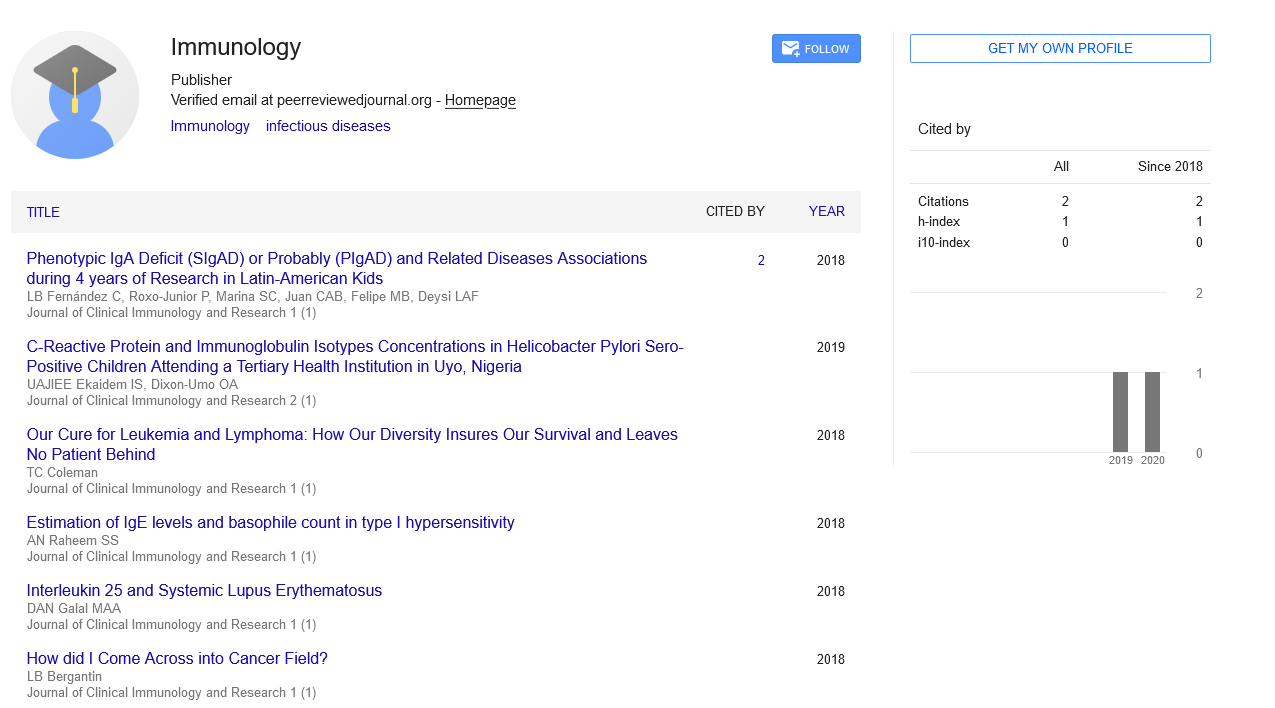Commentary, J Clin Immunol Res Vol: 4 Issue: 3
Tumor Antigen Antibody
Olivia Jhon*
Department of Oncology, Canada Metropolitan Geriatric Medical Center, Canada
*Corresponding author: Basin M, Department of Oncology, Canada Metropolitan Geriatric Medical Center, Canada; E-mail: oliv055@uw.com
Received date: June 02, 2021; Accepted date: June 15, 2021; Published date: June 27, 2021
Keywords: Immunotherapy
Introducion
Cancer may be a broad classification used for the set of diseases characterized by the weird way during which they grow and divide, thereby destroying the healthy cells of the body. People are often exposed to the cancer-causing agents during consuming food, beverage and breathing. In cancer cells the traditional control systems that deter cell overgrowth and therefore the invasion of other tissues are stalled. These doctored cells divide and grow within the response of signals that normally constrain cell growth; thereby not requiring special signals to induce cell growth and division. Tumours are often grouped into benign or malignant. Benign tumours are expunged and, mostly, they are doing not reappear within the body. Cells of benign origin don't expand to other parts of the body and are seldom lives threatening. However, cells in malignant tumours are bizzare and proliferate in an unchecked way. Cancer cells invade and crush the tissue surrounding them and may also break free from a malignant tumour and insuniate into the circulation including blood and lymph. Cancer is that the second leading explanation for mortality worldwide. Although recent years have brought significant clinical successes using adoptive cell therapy an approach during which patient cells are isolated, expanded, and re-infused a number of the continuing challenges include rapid death of transferred cells, poor migration to tumors, and deactivation of cells entering the tumor microenvironment . Current protocols effectively expand and activate T cells ex vivo. However, this approach introduces practical challenges that reduce accessibility of treatment due to the value and complexity of the protocols. Another challenge facing the sector is that the limited control over maintaining T cell expansion and polarization after adoptive transfer while minimizing toxicity and offtarget effects of modulatory cues administered systemically during these treatments. Cancer immunotherapy was developed on the idea of the concept of immune surveillance. During immune surveillance, the system is liable for early detection of abnormal cells and development of an appropriate antitumor response to get rid of cancer cells. The system mounts an antitumor response by detecting tumor-associated antigens; this ability is evidenced by the presence of tumor antigen antibody titers in cancer patients. However, the body isn't ready to generate a sufficient antitumor response because cancer cells can evade detection by the system and inhibit antitumor immune reaction, allowing them to grow and metastasize within the body This experimental sort of immunotherapy is employed to spice up the power of T-cells to fight cancer. Chimeric antigen receptor (CAR) Tcell therapy may be a sort of adoptive cell transfer that's being tested in Australian clinical trials. It’s showing good results for a few sorts of leukaemia and lymphoma. In CAR T-cell therapy, the T-cells are far away from the blood, and a replacement gene is introduced into the Tcells to enable them to recognise cancer cells. The T-cells are then returned to the blood by a drip. The altered T-cells multiply and trigger variety of immune responses that attack the cancer cells. Researchers want to know the tumor microenvironment, and the way a person’s microbiome might influence immunotherapy. Moreover, they're eagerly checking out biomarkers that might tell them if immunotherapy which may take time to point out definitive results is functioning during a patient, says Jaffee and that they also are perusal tissue samples from patients who were treated, trying to differentiate those that answer a given immunotherapy from those that don’t says Kaufman, involves sequencing DNA and RNA, examining epigenetic markers, and visualizing tissues via immunohistochemistry. The first sorts of immune cells involved within the acquired immune reaction are B cells and T cells, which work together to destroy invaders or abnormal cells. so as to recognise foreign organisms/particles or abnormal cells, T cells require the assistance of specialized cells collectively called “antigen-presenting cells” which ingest the invader or abnormal cell and break it up into smaller pieces in order that antigens of the invader or abnormal cell appear to T cells. Cancer immunotherapy may be a treatment strategy which uses a patient's own system to induce or enhance immune responses against cancer. Although immunotherapy has been used for the treatment of a spread of cancers, it represents the youngest pillar of cancer treatments including surgery, chemotherapy and radiotherapy. Indeed, within the past decades there's a growing interest in developing novel cancer immunotherapies with the hope to realize great anti-tumor responses. Unfortunately, the efficacy of immunotherapy is often hampered by several limitations that accompany such treatments. This dissertation is weakened into three separate chapters will give an summary of the present immunotherapeutic strategies with greater description of the restrictions facing cancer immunotherapy and a few potential means to bypass them. will introduce different aspect of the restrictions of cancer treatment will mainly specialise in the systemic toxicities after immunotherapy that occur with age and also provide new means to limit these lethal toxicities will address the shortage of proper immune activation in current immunotherapies. This may be demonstrated by the introduction of novel means to stimulate an immune reaction in weakly immunogenic mouse carcinoma model using magnetic iron particles as an adjuvant therapy together with immunotherapy. Each chapter will give further detailed background information for every material and particularly present potential strategies to beat a number of the restrictions of immunotherapy within the context of cancer treatments.
 Spanish
Spanish  Chinese
Chinese  Russian
Russian  German
German  French
French  Japanese
Japanese  Portuguese
Portuguese  Hindi
Hindi 